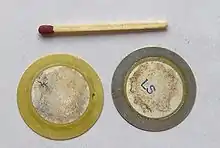Contact microphone
A contact microphone, also known as a piezo microphone,[1] is a form of microphone that senses audio vibrations through contact with solid objects.[2] Unlike normal air microphones, contact microphones are almost completely insensitive to air vibrations but transduce only structure-borne sound. Often used as acoustic leakage probes, they also enjoy wide usage by noise music artists experimenting with sound. Contact microphones can be used to amplify sound from acoustic musical instruments, to sense drum hits, for triggering electronic samples, and to record sound in challenging environments, such as underwater under high pressure.

Contact microphones based on piezo materials are passive and high-impedance, and they sound tinny without a matching preamp.
The most commonly available contact microphone element is made of a thin piezoelectric ceramic round glued to a thin brass or alloy metal disc. This center disc is positively charged while the brass disc is negatively charged. The voltage can be measured across those parts and then amplified to produce sound.[3]
A contact microphone can also be known as an accelerometer microphone. This is fastened below the larynx to produce a signal that is related to the vocal fold vibrations and the sound pressure in the trachea. The waveform produced by the contact microphone is usually independent on articulation. This is due to the high glottal impedance. The signal produced by the contact microphone measures fundamental frequency. The contact microphone is a simple accelerometer containing a piezo-electric ceramic disc as the pick-up unit. The disc is enclosed in a metal container of 15 mm in diameter and 5 mm in thickness and weighs about 20 grams.[4] The positive and negative peaks of the fundamental frequency detector give the signal wave-form which triggers a bistable circuit, so that a square-wave output is obtained having the fundamental frequency of the vibrations sensed by the contact microphone.[5]
See also
References
- Bell, Donald (20 February 2015). "Hear hidden sounds with a DIY microphone". CNET. CBS Interactive. Retrieved 23 May 2019.
- "Contact Microphone". inSync. Sweetwater Sound. 6 April 2017. Retrieved 23 May 2019.
- "Contact Microphones | electronic arts & crafts". Retrieved 2022-03-24.
- Askenfelt, Anders; Gauffin, Jan; Sundberg, Johan; Kitzing, Peter (1 June 1980). "A Comparison of Contact Microphone and Electroglottograph for the Measurement of Vocal Fundamental Frequency". ASHA Wire. doi:10.1044/jshr.2302.258. Retrieved 2022-05-02.
- Askenfelt, A. and Gauffin, J. and Kitzing, P. and Sundberg, J. (1977). "Electroglottograph And Contact Microphone For Measuring Vocal Pitch" (PDF). STL-QPSR. 18: 13–21 – via KTH Computer Science And Communication.
{{cite journal}}: CS1 maint: multiple names: authors list (link)